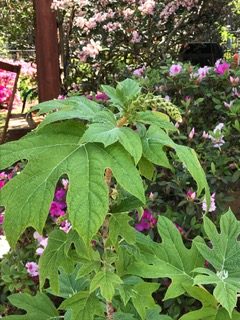Hydrangea quercifolia, or oakleaf hydrangea is a deciduous shrub, that grows up-right and broad-rounded. It is multi-stemmed and spreads by suckering. It may reach 6-to 8-feet tall. Oakleaf hydrangea grows easily in organically rich, medium moisture, well-drained soils in full sun to part shade. It needs some sun to bloom and thrives in moist soil. Mulch can help to retain moisture in the summer. Oakleaf hydrangea blooms on old wood. It should be pruned immediately after flowering although little pruning is usually needed. Winter damaged stems should be removed in early spring. Oakleaf hydrangea has some susceptibility to leaf blight and powdery mildew. Aphids and spider mites are occasional visitors. Deer love this plant. www.plants.ces.NCSU.edu
Oakleaf hydrangea leaves are fuzzy when young. A pyramidal cluster of white blooms matures in late spring and summer, turning purple in the fall. Tiny dry seeds mature in the fall. This hydrangea’s common name is in reference to the leaves that look like those of Quercus (oak). The genus name Hydrangea comes from hydro meaning ‘water’ and aggeion meaning ‘vessel’ in reference to the cup-like capsular fruit. www.Missouribotanicalgarden.org
The hydrangea is at home in a children’s garden, pollinator or native garden, or a night-time garden. There are numerous cultivars available today ranging in color from white to pink or purple. Oakleaf hydrangea is found in many areas of the Brunswick County Botanical Garden.
Information and photos by Jeanne Pavero


